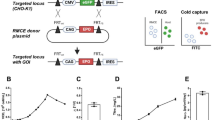Abstract
Productivity of three different promoters at various cell cycle stages and under two distinct growth conditions was examined in Chinese hamster ovary cells. Under the Growth Arrest and DNA Damage inducible GADD153 promoter, productivity of the short half-live variant of the enhanced green fluorescent protein (d2EGFP) and the secreted alkaline phosphatase (SEAP) was highest at the G1 phase of the cell cycle and at serum starvation, while under the cytomegalovirus (CMV) or the simian virus SV40 promoter, productivity was highest at S-phase and in complete medium. These results indicate the utility of the GADD153 promoter for production purposes under protein-free conditions.
Similar content being viewed by others
References
Banik GG, Todd PW Kompala DS (1996) Foreign protein expression from S phase specific promoters in continuous cultures of recombinant CHO cells. Cytotechnology 22: 179–184.
Bi JX, Wirth M, Beer C, Kim EJ, Gu MB, Zeng A-P (2002) Dynamic characterisation of recombinant Chinese Hamster Ovary cells containing an inducible c-fos promoter GFP expression system as a biomarker. J. Biotechnol. 93: 231–242.
Brightwell G, Poirier V, Cole E, Ivins S, Brown KW (1997) Serum-dependent and cell-cycle dependent expression from a cytomegalovirus-based mammalia expression vector. Gene 194: 115–123.
Fornace AFJ, Nebert DW, Hollander MC, Luethy JD, Papathanasiou M, Fargnoli J, Holbrook NJ (1989) Mammalian genes coordinately regulated by growth arrest signals and DNA-damaging agents. Mol. Cell. Biol. 9: 4196–4203.
Gu MB, Todd P, Kompala DS (1994) Analysis of foreign protein overproduction in recombinant CHO cells: effect of growth kinetics and cell cycle traverse. Ann. N.Y. Acad. Sci. 721: 194–207.
Hayter PM, Curling EMA, Baines AJ, Jenkins N, Salmon I, Strange PG, Bull AT (1991) Chinese hamster ovary cell growth and interferon production kinetics in stirred batch culture. Appl. Microbiol. Biotechnol. 34: 559–564.
Lee FWF, Elias CB, Todd P, Kompala DS (1998) Engineering Chinese hamster ovary (CHO) cells to achieve an inverse growthassociated production of a foreign protein, ?-galactosidase. Cytotechnology 28: 73–80.
Suzuki E, Ollis DF (1990) Enhanced antibody production at slowed growth rate: experimental determination and a simple structured model. Biotechnol. Prog. 6: 231–236.
Tonouchi N, Koyama N, Miwa K (1992) A CHO strain producing high-level human IL-6 with the 3? deletion construct. J. Biotechnol. 22: 283–290.
Yang T-T, Sinai P, Kitts P, Kain SR (1997) Quantification of gene expression with a secreted alkaline phosphatase reporter system. Biotechniques 23: 1110–1114.
Author information
Authors and Affiliations
Rights and permissions
About this article
Cite this article
de Boer, L., Gray, P.P. & Sunstrom, NA. Enhanced productivity of G1 phase Chinese hamster ovary cells using the GADD153 promoter. Biotechnology Letters 26, 61–65 (2004). https://doi.org/10.1023/B:BILE.0000009462.10772.a4
Issue Date:
DOI: https://doi.org/10.1023/B:BILE.0000009462.10772.a4




